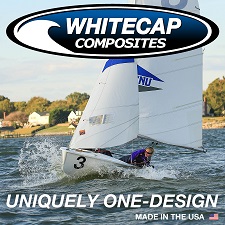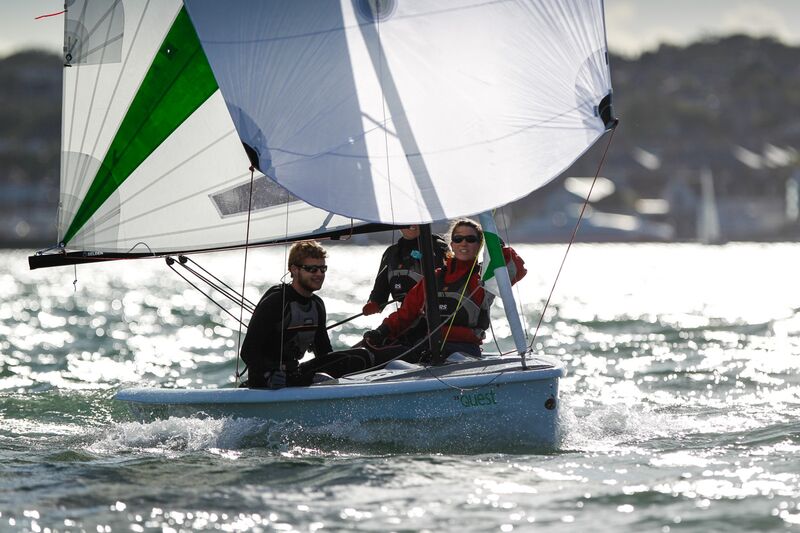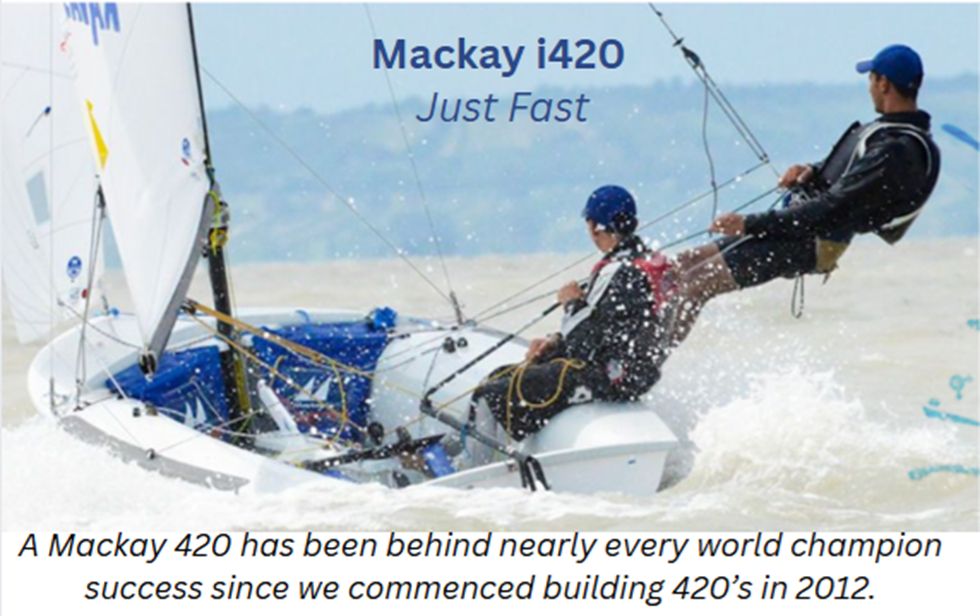By Airwaves writer Andrew Kerr
The call of “change the headsail “has resonated with teams since the inception of competitive sailing.
It is one of the ultimate calls to action for a team as the crew hurriedly goes about their tasks, very often under the pressure of time, tactical needs and weather concerns.

I was onboard Chris Snow’s boat (# 5208) and doing the bow, what was not routine about the day was the fact that the wind was taking a little longer to fill in than normal and we had sailed the first race of the day with the Genoa, ordinarily we would of expected to of changed down to the jib at some stage during that race or at least at the conclusion of it.
We kept looking upwind at the famed Golden Gate Bridge and the fog was still over the bridge and boats sailing around the bay were very underpowered. “It was supposed to be 90 degrees in Oakland by now” someone said. With just over 6 minutes to go the fleet was starting to put up Genoa’s and jockey for position on the starting line.
At about 5 minutes and 20 seconds to go – here came the classic Summer San Francisco breeze – all 22 knots of it. Boats charged around the starting line deliberating whether they had enough time to change.
You could almost feel the anxiety in the fleet as teams weighed up the options of being grossly overpowered at the start or even the prospect of having no headsail at the start.
On our boat there was no deliberating – up came the flaked Jib and our mast person, middleperson and cockpit person and I started the change.
Very little was said – Chris kept maneuvering us close to the line, was conscious of the lay line to the pin end of the line and kept the boat moving well to retain good steerage. The middle person called time and talked strategy / tactics with Chris, the dialogue was as if there was 10 minutes to go – calm and concise.
At about 1 minute to the start the Jib went up to the predetermined halyard tension and we got a good start toward the pin end of the line.
The quick decision, the skippers good presence of mind and the team work that went in to the change was a race and regatta saver and enabled our team t get off the line clean and sail fast upwind while other teams were not as fortunate.
This experience high lighted many facets of the effective headsail change – let’s look at the successful elements behind this dynamic challenge to a team. A lot of these ideas have been race savers in a wide variety of race locations – very often the team will encounter 2 or even 3 sail change ( sometimes more) on a 3 race day featuring changeable weather patterns.
For the purpose of this article we will assume we are hanking on the headsails, ( as opposed to using a head foil) that we are sailing windward/ leeward courses of 1 to 2 miles in length and that the sail changes will be done either prior to the start, between races or sailing downwind with the spinnaker up.
We will also assume that we have a five person team and divide the tasks accordingly.
Let’s take a look at a suggested check list for your team –
Preparation Checklist for a fast change:
(The example given is going from a Genoa to a Jib and applies changing up to the Genoa with a few minor differences):
- Mark the jib tracks for the fast setting so that you know where the Jib fairlead block has to go.
- Mark the Halyard on the Jib so you have a basic idea where the halyard tension will go to.
- Make sure the hanks on the halyards run smoothly and are not frozen or difficult to open.
- Make sure the Jib Blocks are readily available and stored in a commonly known place which is easily accessible.
- Have both the middle & Bow crew have a roll of white tape accessible – for taping the snap shackle on the Jib halyard.
- Flake the headsail(s) you are not using, fold it in to thirds and place a loose sail tie around it. This will be much faster than having to unroll the sail under the pressure of limited time. We tend to do this mainly on bigger boats unless the need for a change is typically predictable based on the typical conditions – i.e. – San Francisco bay in the summer time.
- Reeve an extra set of Jib sheets on to the headsail you are not using – saves time.
- Store the flaked (or rolled) headsail with the tack facing forward – this will enable you to place it on deck facing the right way to be hanked on.

Skipper:
If before the start – keep the boat moving well and close to the line. Avoid getting stuck in irons with the main only!
Don’t get too far away from the line!
Very often a team will have a tendency to get sidetracked when changing before the start – keep the boat close to the line so you aren’t late. Being late to the line is a common tendency to be avoided.
– If the line is restricted for another fleet then sail up and down from an extension of the line (keeping well clear of the other fleet) so you can continue to make observations and to be able to enter the area quickly when it becomes your line.
If possible steer to keep the boat level and the crew as dry as is practically possible. This is not always possible but something to strive for and can win bonus points back at the club!
Keep you head out of the Boat!!
Some skippers will have a tendency get too involved with what the crew is doing with a pre start sail change and have a disastrous start as a result – avoid this micromanagement!
When sailing bareheaded it is almost like you are sailing a laser – sailing by the main, keeping speed up and maneuvering as smoothly as possible.
Monitor time and RC signal flags and be conscious of the the approach to the line and the lay lines to the start. Keeps the dialogue going with the tactician on where wants to start and encourage him or her to keep making tactical and strategic observations and to keep looking upwind for any changes and to reassess any initial assumptions.
If the tactician is pre occupied through mother of necessity (i.e. You are shorthanded or have an inexperienced team or team members) then you will have to be the one to make the observations.
Business as usual – we are starting as well as the team can in the circumstances.
If sailing Downwind:
If sailing downwind under spinnaker – move your weight aft a little and steer to compensate for the bow being down by the forward weight of the bow crew changing the headsail.
If it’s windy you will want to encourage crew that are not directly involved with the change to get there weight aft to stop the bow submarining and the boat rounding up.
Keep the boat sailing fast and don’t get involved with the sail change – let the crew do their thing and keep the boat well positioned. Again – a business as usual approach – you will want to avoid any luffing duels (typically to be avoided any way!) and keep the dialogue going with the trimmer (s) on speed and the tactician on positioning versus the other boats and the velocity and shifts.
Cockpit:
Generally the cockpit person doesn’t seem to get a vote on whether the team changes to the jib from the Genoa! Could it be that tacking the Genoa in 18 knots is a physical challenge?! !
That being said – if the team has to change very quickly before the start then the cockpit person can help reeve the jib sheets through the ratchet blocks and also participate in a quick flake in the headsail.
More importantly, they can work with the skipper on monitoring the time, reminding the skipper to stay close to the line and also monitoring fleets that have started ahead of you.
If the tactician is in the middle person position then it is a very good idea to have the cockpit person assumes the middle person’s role on the change before the start. This free’s up the middle/ tactician to keep looking around and make tactical observations. This crew organizational flexibility is the hallmark of a good team.
Middle: (Very often the tactician as well).
– If the tactician and you are changing headsails before the start – consider trading roles with the cockpit person (as noted above) to free your self up to look around and make tactical and strategic observations.
– Bring the new headsail up on deck, locate & pass the jib blocks to the mast person.
– Keep monitoring time and stay aware of distance to the starting line.
– If time – help the mast person flake the Genoa, if no time – store gently below with the tack facing forward.
– If changing downwind – reeve the jib sheets through the ratchet blocks as the cockpit person will be preoccupied with trimming the spinnaker. If you are under a lot of time pressure then just reeve the expected needed (loaded) jib sheet. Be sure to budget a few seconds to make sure it is the correct way through the ratchet block and has a stopper knot in the end. The pressure of a lack of time can force basic errors like this!
– A nice feature of the active middle person is also to load the jib sheet on to the expected winch (cross sheeted) and cleat it ( with the sail eased well out) – as the cockpit person will very often have their hands full trimming the spinnaker going in to the leeward mark.
Mast:
– Take the jib halyard from the bow person and attach to the bale on the mast.
– When the bow is unhanking the old sail and hanking on the new sail – watch or hold the leech and clew of the sail as these will have a tendency to wash over the side in rough conditions.
– Take the old sail from the bow person and pass the new sail to the bow person with the tack facing forward for quick attachment.
- If there is time – help the bow & middle (or cockpit) flake the sail (if possible).
If not enough time – pass the sail back to the middle person who can gently store it down below with the tack facing forward.
– If there is a lot of time and it is a permanent change (particularly if the wind is fading toward the end of the day and you are going to the Genoa) then you may consider rolling the sail.
– Put the jib blocks to the pre marked setting on the tracks.
– Reeve the jib sheets through the jib blocks and pass them back (be careful to go under the spinnaker sheets on the port side) to the middle person for reeving through the ratchet blocks.
– If necessary – pass the jib halyard forward from the mast bale (look aloft to make sure it isn’t fouled) and be ready with a back up roll of white tape to tape the halyard snap shackle. The bow person should have this done but it’s always’s good to have a back up.
Generally you won’t have enough hands to flake the sail when going downwind with the spinnaker up as the team will be preoccupied with trimming, positioning & going fast – in this instance passing the sail back to the middle person for storage( with the tack facing forward) will be the way to go.
– If you are changing downwind with the spinnaker up then be prepared to jibe the spinnaker pole while the bow crew is pre occupied.
– When it is time – raise the headsail & set the halyard tension to the pre marked setting.
Bow:
Make sure you stay on the boat! Keep low and move deliberately. ! One hand for your self and one for the boat!!
- Take the halyard off and either put it back on the bail on the mast or pass it back to the middle to attach on to the bail.
- UN hank the sail with sail between your knees so it can’t fall over the side.
- Hank on the new headsail and reattach the halyard (take time to make sure it isn’t fouled aloft) – if you use a snap shackle be sure to tape the shackle closed.
Note: Do you notice that during the fall and spring that this is the time that the tips of your fingers feel particularly frozen!!!
Practice!
It’s a terrific idea to practice changing from Jib to Genoa and back with your older sails.
Do it both downwind with the spinnaker up and also reaching around as if you were in the pre start area. When coaching teams in practice sessions I have timed them in both scenarios and we have strived to reduce the time after each practice change.
Conclusion:
Changing headsails quickly and efficiently is another dynamic team skill that can help your team win races and fulfill its potential over the course of a series.
Take the time to practice it early in the season with your older sails and as a team – take some time to talk about each team member’s role, it will pay dividends at crunch time!



 Learn more about Great Harbor Yacht Club’s Sailing Program
Learn more about Great Harbor Yacht Club’s Sailing Program 
 The United States government leased the Club property in 1943 for the duration of the war plus six months for use as an Air Force Crash Boat Rescue Base. The club regained control of its property in January 1946 with the payment of $100.00 to the United States government for improvements made to the site, mainly two barracks buildings, which served as a clubhouse for many years. During the war period the membership declined to 66 regular members. A new clubhouse was built in 1958.
The United States government leased the Club property in 1943 for the duration of the war plus six months for use as an Air Force Crash Boat Rescue Base. The club regained control of its property in January 1946 with the payment of $100.00 to the United States government for improvements made to the site, mainly two barracks buildings, which served as a clubhouse for many years. During the war period the membership declined to 66 regular members. A new clubhouse was built in 1958.
 The Comet was designed by C. Lowndes Johnson as a trailerable version of the Star. The design combines a 16 foot hard chine planing hull with a classic sloop rig. Her light weight (260 lbs.), generous sail area (140 sq. ft.) and semi-flat bottom, make her easily driven to weather and can be planed off the wind in breezes of only 10 to 12 knots. The Comet carries a mainsail and jib, the mast stands twenty feet five inches above the deck and is supported by a fully adjustable three stay rig. The hulls feature watertight side tanks and a false bottom which is self-bailing in the event of a capsize. The boat has evolved greatly since 1932 and has kept pace with the times. The modern Comet sports “Go Fasts” such as vang sheeting, mast benders and depending on the skipper’s appetite for complexity, ball bearing travelers, and magic boxes for mast rake control. All sail adjustments may be placed on the cockpit coaming, to be at fingertip control from a fully hiked position.
The Comet was designed by C. Lowndes Johnson as a trailerable version of the Star. The design combines a 16 foot hard chine planing hull with a classic sloop rig. Her light weight (260 lbs.), generous sail area (140 sq. ft.) and semi-flat bottom, make her easily driven to weather and can be planed off the wind in breezes of only 10 to 12 knots. The Comet carries a mainsail and jib, the mast stands twenty feet five inches above the deck and is supported by a fully adjustable three stay rig. The hulls feature watertight side tanks and a false bottom which is self-bailing in the event of a capsize. The boat has evolved greatly since 1932 and has kept pace with the times. The modern Comet sports “Go Fasts” such as vang sheeting, mast benders and depending on the skipper’s appetite for complexity, ball bearing travelers, and magic boxes for mast rake control. All sail adjustments may be placed on the cockpit coaming, to be at fingertip control from a fully hiked position.


